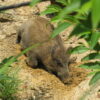University of Minnesota scientists are partnering with a global team to study the complex effects of climate change on winter crops.
Warming winters may sound like a welcome change for some farmers because the change in temperature could reduce freezing stress on plants and create more ideal conditions for growing overwinter cash crops and winter cover crops. However, when looking at climate change from a cross-seasonal perspective and accounting for declining snowpack, researchers are finding that the whole picture isn’t so sunny.
Reduced snow may result in more exposure of winter crops to freeze and could mean greater risks for agricultural drought.
In a new study published in Nature Climate Change, Zhenong Jin, Ph.D., an assistant professor in the Department of Bioproducts and Biosystems Engineering at the University of Minnesota, led an international team in researching the implications that could be associated with warmer winters and declining snowpack, using winter wheat (the largest winter crop in the U.S.) as an example.
“Although the implications of changes in snow for agricultural irrigation are beginning to be understood, the consequences of such for predominantly rainfed winter crops such as winter wheat remain largely unknown. There might be risks for being overoptimistic about growing overwinter crops under climate change,” said Jin.
Researchers used panel regression, a powerful statistical method to analyze repeated observations over time, to attribute the interannual variability of winter wheat yield to multiple interactive environmental factors. These factors included cold season freezing degree days, growing degree days, rainfall and snowfall during the growing season and snow cover fraction during frozen days.
The researchers found:
From 1999-2019, snow cover insulation weakened yield losses due to freezing stress by 22%.Projections show that future reduced snow cover could offset up to one-third of the yield benefit from reduced frost.
“Our study highlighted the potential freezing risk in winters with decreased snow cover, especially when seedlings were exposed to comparatively warmer conditions that caused loss of winter-hardiness, which can cause significant yield losses of winter crops,” said Peng Zhu, Ph.D., a Researcher from the Climate and Environment Sciences Laboratory of the Pierre Simon Laplace Institute, who co-led this study.
This research will help inform breeders as they consider the complex tradeoffs among warming, reduced snowpack and occasional freezing threats when developing climate-smart cultivars.
These results also highlight the necessity of improving the representation of snow associated processes in crop models to better evaluate climate change effects and adaptation potential in cropping systems.
“It is worth noting that in some cropping systems freezing stress is appreciated, since it helps farmers control pests and diseases and snow is even removed or at least made more compact by farmers to increase the freezing of the soil,” said Jin. “When data becomes available, future studies might also need to account for the influence of snow on pests and diseases to comprehensively understand what future changes in snowpack mean for the cropping system.”
Other members of the University of Minnesota research team include Taegon Kim and Chenxi Lin from Jin’s group and David Mulla from the Department of Soil, Water, and Climate.
More information:
Peng Zhu et al, The critical benefits of snowpack insulation and snowmelt for winter wheat productivity, Nature Climate Change (2022). DOI: 10.1038/s41558-022-01327-3
Provided by
University of Minnesota
Citation:
Critical benefits of snowpack for winter wheat are diminishing (2022, April 7)



